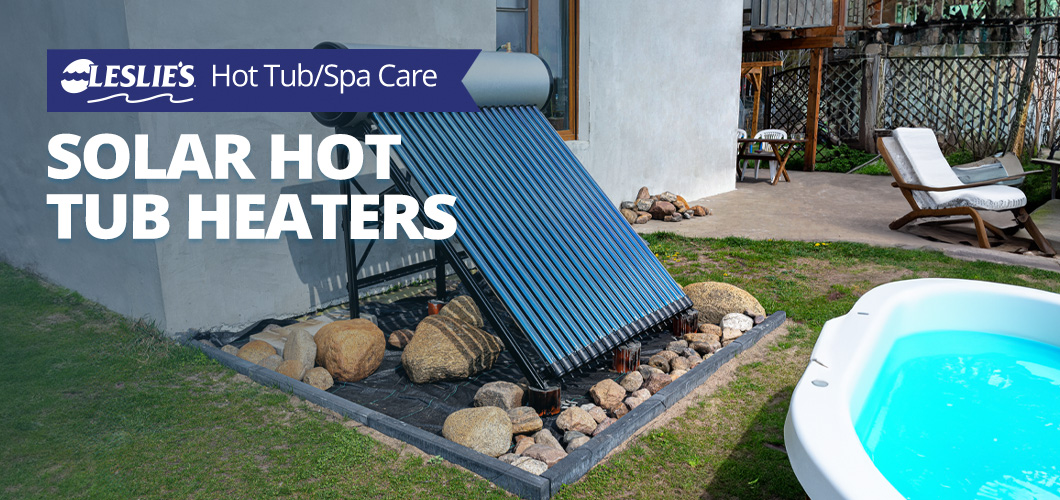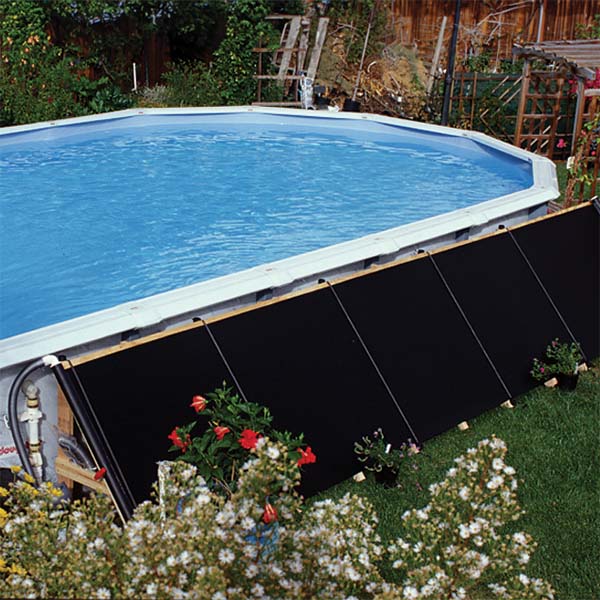
Solar Hot Tub Heaters
Solar hot tub heaters are all the rage now for off-the-grid homes and campsites, or for anyone who wants to operate a spa or hot tub in an eco-friendly way. Can a solar pool heater be used to heat a spa? You betcha! And it's a simple Saturday project. Solar hot tub heaters can heat up a hot tub to over 100°F with just 6 hours of sunshine - ready to use when you come home from work!
Your hot tub cover will retain the heat from a solar heater until well into the evening. And if needed, you can use an alternate spa heater or hot tub heater for night.
How to Install a Solar Hot Tub Heater

1. Location of Solar Panels:
The first thing to think of is where and how the solar panels are going to be mounted. If you have full sun all day long, you could just lay them on the ground, but for most folks, mounting them on a roof or rack at a 30°F–45°F angle works best. A rack can be built of angle iron or lumber, topped with plywood or plastic and painted black. You can also hang them on a fence. Choose a spot that will get at least 6 hours of daily sun; a southern facing direction is best.
2. Buy a Solar Pool Panel:
A single 4' x 20' solar panel, a total of 80 square feet, is a good size for most spas. There are also 4' x 10' panels, but they are priced higher per square foot of panel. 80 sq. ft. of solar panel will heat spas under 500 gallons to over 100°F during the day, and be ready to go for the evening. If you want to heat the hot tub in under an hour like my friend with the pool/spa, you'll need 4–5 of the 20' solar panels.
3. Installation of Hot Tub Solar Panels:
Solar pool panels are polypropylene mats of small black tubes with a continuous backing, so they absorb more heat than black hose DIY solar spa heaters. Inside the box will be two 2'x20' solar panels, end caps, pipe adapters, mounting kit and a 3-way diverter valve. Secure the panels to the location securely so they are protected from high winds, animals and tree branches. Attach the end caps, and run PVC pipe from the panels to the plumbing line of the spa.
4. Plumbing a Solar Hot Tub Heater:
This part is custom for every spa or hot tub, but essentially you connect the plumbing from solar panels to the spa. A 3-way diverter valve will allow for adjusting the flow rate, and for shutting off the solar panels completely. Other items needed for plumbing beside the pipe include some directional fittings (90's or 45's) and couplings to connect lengths of pipe. A check valve is needed just before the heated water comes back into the spa plumbing, to prevent water cycling.
Other Thoughts About Solar Hot Tub Heaters
- A solar controller can be used with an automatic valve turner and temperature sensors to have thermostat control for the solar spa heater, but more importantly, to shut off the unit when conditions are not right for solar, at night or when it's raining, for instance. This is an extra $325, but is recommended for optimum heating, neither under or overheating the spa.
- Speaking of overheating, it is possible to overheat the water with a solar spa heater. If you have an electric spa heater, the hi-limit may trip and shut off the spa pump, but at that point the water may already be dangerously hot. Use caution not to heat the water over 104°.
- As mentioned before, hot tub solar heaters don't work at night, or when it's raining or heavily overcast. They drop way off in effectiveness during the winter months, unless you are in the very deep southern U.S..
- A booster pump is not usually needed for installation on a roof, unless the roof is very tall. If a booster pump is needed, these small spa circulation pumps are perfect for the job.
- For best results, use an insulated spa cover to retain the heat, and a solar controller to optimize when the solar panels are used, and to maintain safe water temperatures.
Solar hot tub heaters work well in parts of the U.S. that have at least 6 hours of unobstructed sun. For many hot tubs, solar heat is used as a supplemental heater to keep the spa hot during the day, and at night or during rainy periods, the other spa heater takes over.